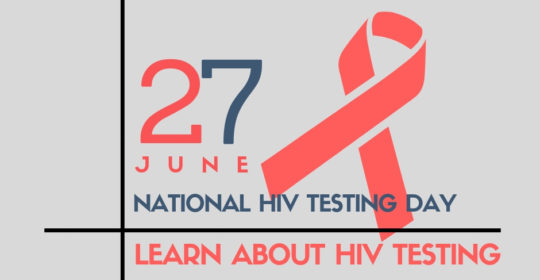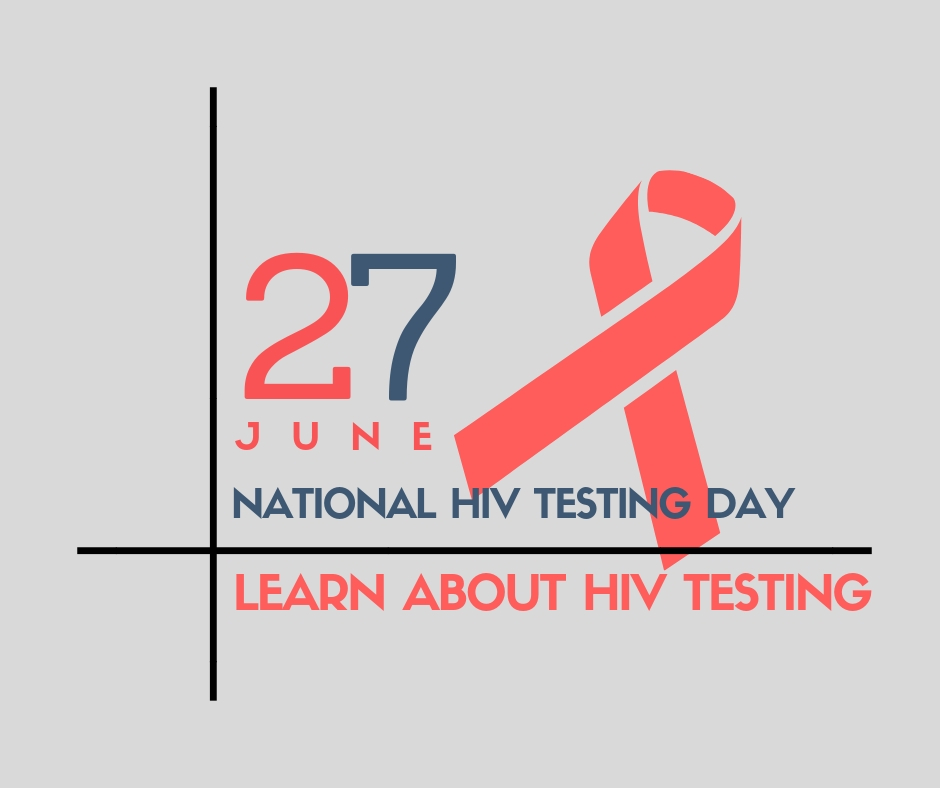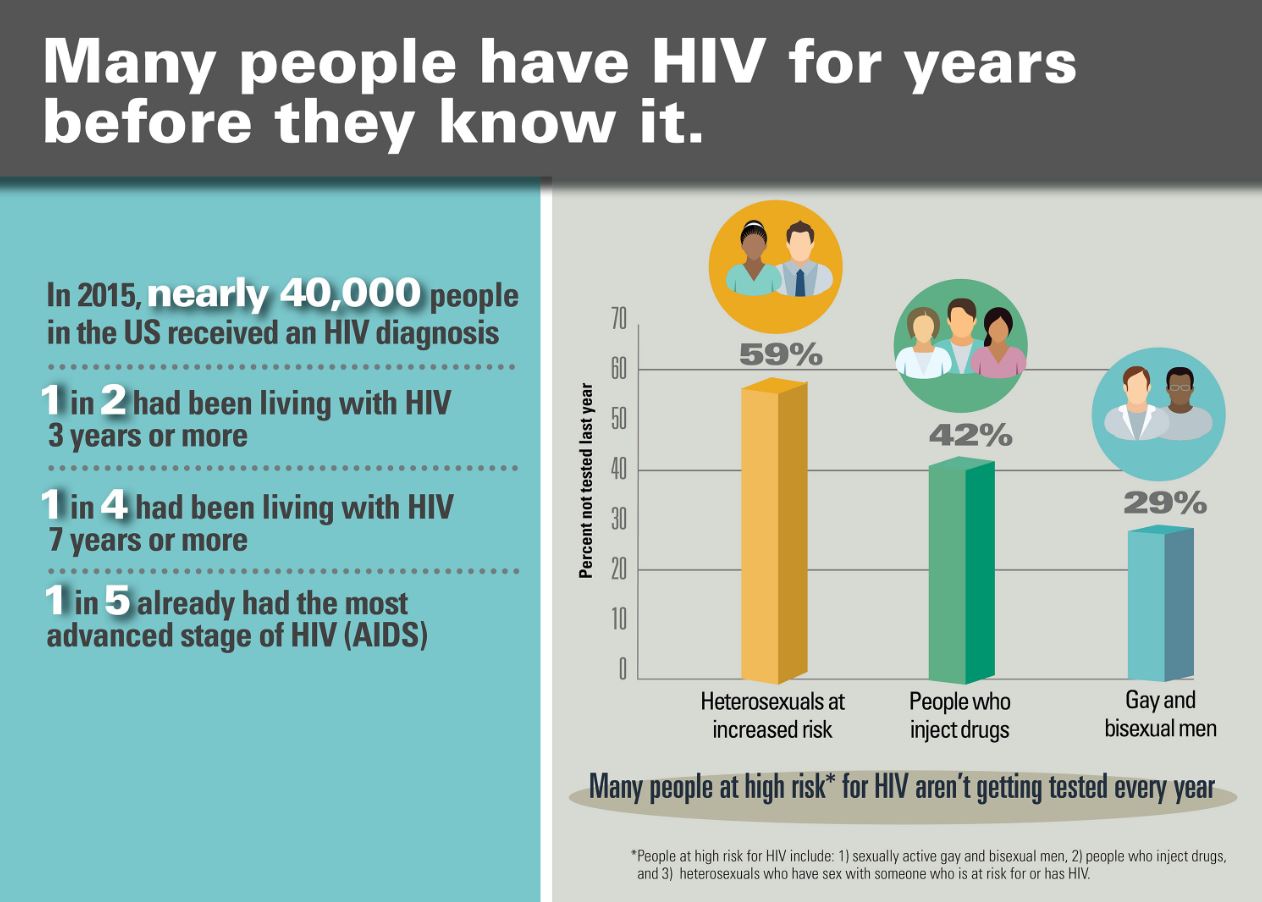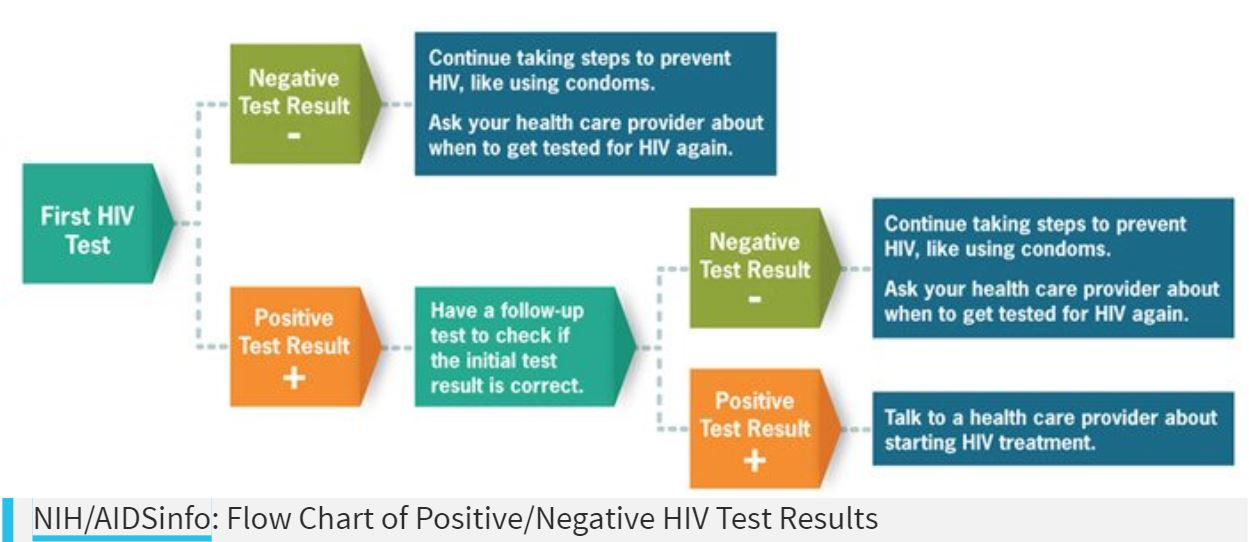
National HIV Testing Day

National HIV Testing Day (NHTD) was first observed on June 27, 1995. NHTD is a day to encourage people to get tested for HIV, know their status, and get linked to care and treatment.
CDC recommends that everyone between the ages of 13 and 64 get tested for HIV at least once as part of routine health care. Knowing your HIV status gives you powerful information to help you take steps to keep you and your partner(s) healthy. About 1 in 7 people in the United States who have HIV do not know they have it.

Learn About HIV Testing
What is HIV testing?
HIV testing shows whether a person has HIV. HIV stands for human immunodeficiency virus. HIV is the virus that causes AIDS (acquired immunodeficiency syndrome). AIDS is the most advanced stage of HIV infection.
HIV testing can detect HIV infection, but it can’t tell how long a person has had HIV or if the person has AIDS.
Who Should Get Tested?
Everyone between the ages of 13 and 64 should get tested for HIV at least once. If your behavior puts you at risk after you are tested, you should think about being tested again. Some people at higher risk should get tested more often.
If your last HIV test result was negative, you should get an HIV test if you answer “yes” to any of the questions below about your risk since that test:
- Are you a man who has had sex with another man?
- Have you had sex—anal or vaginal—with an HIV-positive partner?
- Have you had more than one sex partner?
- Have you injected drugs and shared needles or works (for example, water or cotton) with others?
- Have you exchanged sex for drugs or money?
- Have you been diagnosed with, or sought treatment for, another sexually transmitted disease?
- Have you been diagnosed with or treated for hepatitis or tuberculosis (TB)?
- Have you had sex with someone who could answer “yes” to any of the above questions or someone whose sexual history you don’t know?
Sexually active gay and bisexual men may benefit from more frequent testing (for example, every 3 to 6 months).
If you’re pregnant, talk to your health care provider about getting tested for HIV and other ways to protect you and your child from getting HIV.
Anyone who has been sexually assaulted or has had a high-risk exposure to HIV should consider taking post-exposure prophylaxis (PEP) and getting an HIV antigen test that can detect infection sooner than standard antibody testing. PEP may prevent HIV infection after possible exposure to HIV if it is started as soon as possible within 3 days after exposure to HIV.
How Can Testing Help You?
The only way to know for sure whether you have HIV is to get tested.
Knowing your HIV status gives you powerful information to help you take steps to keep you and your partner(s) healthy.
- If you test positive, you can take medicine to treat HIV . People with HIV who take HIV medicine as prescribed can live long and healthy lives. There’s also an important prevention benefit. If you take HIV medicine daily as prescribed and get and keep an undetectable viral load, you have effectively no risk of transmitting HIV to an HIV-negative partner through sex.
- If you test negative, you have more prevention tools available today to prevent HIV than ever before.
- If you are pregnant, you should be tested for HIV so that you can begin treatment if you’re HIV-positive. If an HIV-positive woman is treated for HIV early in her pregnancy, the risk of transmitting HIV to her baby can be very low.
Should You Get Tested for HIV If You Don’t Think You’re at High Risk?
Some people who test positive for HIV were not aware of their risk. That’s why CDC recommends that everyone between the ages of 13 and 64 get tested for HIV at least once as part of routine health care and that people with certain risk factors should get tested more often (see above).
Even if you are in a monogamous relationship (both you and your partner are having sex only with each other), you should find out for sure whether you or your partner has HIV.
Should You Get Tested for HIV If You’re Pregnant?
All pregnant women should be tested for HIV so that they can begin treatment if they’re HIV-positive. If a woman is treated for HIV early in her pregnancy, the risk of transmitting HIV to her baby can be very low. Testing pregnant women for HIV infection, treating those who are infected, and treating their babies with antiretroviral therapy (ART) after delivery have led to a big decline in the number of children born with HIV.
The treatment is most effective for preventing HIV transmission to babies when started as early as possible during pregnancy. If pregnant women are treated for HIV early in their pregnancy, the risk of transmitting HIV to their baby can be 1% or less. However, there are still great health benefits to beginning preventive treatment even during labor or shortly after the baby is born.
Where Can You Get Tested for HIV?
You can get an HIV test at many places:
- Your health care provider’s office
- Health clinics or community health centers
- STD or sexual health clinics
- Your local health department
- Family planning clinics
- VA medical centers
- Substance abuse prevention or treatment programs
Many pharmacies and some community-based organizations also offer HIV testing.
HIV testing is covered by health insurance without a co-pay, as required by the Affordable Care Act. If you do not have health insurance, some testing sites may offer free tests.
These places can connect you to HIV care and treatment if you test positive or can discuss the best HIV prevention options for you if you test negative.
You can also buy a home testing kit at a pharmacy or online.
What Can You Expect When You Go in for an HIV Test?
If you take a test in a health care setting, when it’s time to take the test, a health care provider will take your sample (blood or oral fluid), and you may be able to wait for the results if it’s a rapid HIV test. If the test comes back negative, and you haven’t had an exposure for 3 months, you can be confident you’re not infected with HIV.
If your HIV test result is positive, you may need to get a follow-up test to be sure you have HIV.
Your health care provider or counselor may talk with you about your risk factors, answer questions about your general health, and discuss next steps with you, especially if your result is positive.
How Soon After Exposure to HIV Can an HIV Test Detect If You Are Infected?
No HIV test can detect HIV immediately after infection. If you think you’ve been exposed to HIV, talk to your health care provider as soon as possible.
The time between when a person gets HIV and when a test can accurately detect it is called the window period. The window period varies from person to person and also depends upon the type of HIV test.
- Most HIV tests, including most rapid tests and home tests, are antibody tests. Antibodies are produced by your immune system when you’re exposed to viruses like HIV or bacteria. HIV antibody tests look for these antibodies to HIV in your blood or oral fluid. It takes time for the body to produce enough antibodies for an HIV test to show that a person has HIV.
- The soonest an antibody test will detect infection is 3 weeks. Most (approximately 97%), but not all, people will develop detectable antibodies within 3 to 12 weeks (21 to 84 days) of infection. If you have any type of antibody test and have a positive result, you will need to take a follow-up test to confirm your result.
- A combination, or fourth-generation, test looks for both HIV antibodies and antigens. Antigens are foreign substances that cause your immune system to activate. The antigen is part of the virus itself and is present during acute HIV infection (the phase of infection right after people are infected but before they develop antibodies to HIV). Combination tests are now recommended for HIV testing that’s done in labs and are becoming more common in the U.S.
- Most, but not all people, will make enough antigens and antibodies for fourth-generation or combination tests to accurately detect infection 2 to 6 weeks (13 to 42 days) after infection.
- A nucleic acid test (NAT) looks for HIV in the blood. It looks for the virus and not the antibodies to the virus. This test is very expensive and not routinely used for screening individuals unless they recently had a high-risk exposure or a possible exposure with early symptoms of HIV infection.
- Most, but not all people, will have enough HIV in their blood for a nucleic acid test to detect infection 1 to 4 weeks (7 to 28 days) after infection.
Ask your health care provider about the window period for the test you’re taking and whether you will need a follow-up test to confirm the results. If you’re using a home test, you can get that information from the materials included in the test’s package. If you get an HIV test within 3 months after a potential HIV exposure and the result is negative, get tested again in 3 more months to be sure.
If you learned you were HIV-negative the last time you were tested, you can only be sure you’re still negative if you haven’t had a potential HIV exposure since your last test. If you’re sexually active, continue to take actions to prevent HIV, like using condoms the right way every time you have sex and taking medicines to prevent HIV if you’re at high risk.
Understanding HIV Test Results
HIV testing shows whether a person is infected with HIV. HIV stands for human immunodeficiency virus. HIV is the virus that causes AIDS (acquired immunodeficiency syndrome). AIDS is the most advanced stage of HIV infection. Learn about what a positive and negative HIV test result mean.

What Does a Negative HIV Test Result Mean?
A negative result doesn’t necessarily mean that you don’t have HIV. That’s because of the window period—the time between when a person gets HIV and when a test can accurately detect it. The window period varies from person to person and is also different depending upon the type of HIV test.
Ask your health care provider about the window period for the kind of test you’re taking. If you’re using a home test, you can get that information from the materials included in the test’s package. If you get an HIV test after a potential HIV exposure and the result is negative, get tested again after the window period for the test you’re using to be sure. To learn more about the window period and when a person should get retested, see CDC’s How soon after an exposure to HIV can an HIV test if I am infected?. If you get an HIV test within 3 months after a potential HIV exposure and the result is negative, get tested again in 3 more months to be sure.
If you learned you were HIV-negative the last time you were tested, you can only be sure you’re still negative if you haven’t had a potential HIV exposure since your last test. If you’re sexually active, continue to take actions to prevent HIV, like using condoms the right way every time you have sex and taking medicines to prevent HIV if you’re at high risk.
If You Have a Negative Test Result, Does that Mean that Your Partner Is HIV-Negative Also?
No. Your HIV test result reveals only your HIV status.
HIV is not necessarily transmitted every time you have sex. Therefore, taking an HIV test is not a way to find out if your partner is infected.
It’s important to be open with your partner(s) and ask them to tell you their HIV status. But keep in mind that your partner(s) may not know or may be wrong about their status, and some may not tell you if they have HIV even if they know they’re infected. Consider getting tested together so you can both know your HIV status and take steps to keep yourselves healthy.
What Does a Positive HIV Test Result Mean?
If you have a positive HIV test result, a follow-up test will be conducted. If the follow-up test is also positive, it means you are HIV-positive.
If you had a rapid screening test, the testing site will arrange a follow-up test to make sure the screening test result was correct. If you used a self-testing kit at home, a positive HIV test result must always be confirmed by additional HIV testing performed in a health care setting. If your blood was tested in a lab, the lab will conduct a follow-up test on the same sample.
If your follow-up test result confirms you are infected with HIV, the next thing is to take steps to protect your health and prevent transmission to others. Begin by talking to your health care provider about antiretroviral therapy (ART). ART is the use of HIV medicines to treat HIV infection. People on ART take a combination of HIV medicines every day. ART can keep you healthy for many years and greatly reduces your chance of transmitting HIV to your sex partner(s) if taken the right way, every day. Your health care provider will help you decide what HIV medicines to take.
If you have health insurance, your insurer is required to cover some medicines used to treat HIV. If you don’t have health insurance, or you need help because your insurance doesn’t pay for the treatment you need, there are Federal resources that may help you.
To lower your risk of transmitting HIV,
- Take medicines to treat HIV (antiretroviral therapy or ART) the right way every day so that you achieve and maintain an undectable viral load.
- Use condoms the right way every time you have sex. Learn the right ways to use a male condom and a female condom.
- If your partner is HIV-negative, encourage them to talk to their health care provider to see if taking daily medicine to prevent HIV (called pre-exposure prophylaxis, or PrEP) is right for them.
- If you think your partner might have been recently exposed to HIV—for example, if the condom breaks during sex and you are not virally suppressed—they should talk to a health care provider right away (no later than 3 days) about taking medicines (called post-exposure prophylaxis, or PEP) to prevent getting HIV.
- Get tested and treated for STDs and encourage your partner to do the same.
Receiving a diagnosis of HIV can be a life-changing event. People can feel many emotions—sadness, hopelessness, and even anger. Allied health care providers and social service providers, often available at your health care provider’s office, will have the tools to help you work through the early stages of your diagnosis and begin to manage your HIV.
Talking to others who have HIV may also be helpful. Find a local HIV support group. Learn about how other people living with HIV have handled their diagnosis.
You can view stories and testimonials of how people are staying adherent to their HIV treatment and living well with HIV by visiting HIV.gov’s Positive Spin.
If You Test Positive for HIV, Does That Mean You Have AIDS?
No. Testing positive for HIV does not mean you have AIDS. AIDS is the most advanced stage of HIV disease. HIV can lead to AIDS if not treated.
Source:
- HHS
- NIH


Most Commented